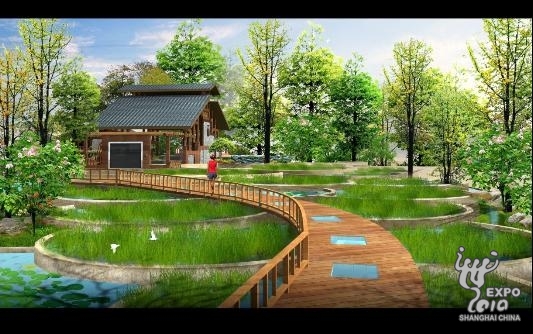Living water park of Chengdu
The Living Water Park is very popular among Chengdu citizens in western China. Clusters of pools of various shapes and anchored by fancy sculptures can be seen everywhere; children are often seen racing their inflated balls on streams that rush and splash about the fluid art. Many trees, plants and flowers transform the park into a rainbow of colors. Walking along the shaded lakeside trail, one can see waterwheels and plank bridges this side, and terraced fields that cover the hillsides on the other side of the embankment.
 |
| Chengdu Case Pavilion |
This is China's first water conservation theme park. It provides solutions and alternatives for cities that are troubled by the treatment of wastewater and is therefore made it into the Best Urban Practice Area (BUPA) selections for the Shanghai Expo.
Water Treatment the Natural Way
The park functions as a water treatment plant. Polluted water is channeled into an artificial wetland to go through a comprehensive natural treatment process and comes out pristine at the extremities.
The Funan River that cuts through the city proper was once badly polluted by sewage and became filthy and smelly. Today it is channeled into an underground reservoir from where it flows through anaerobic precipitating pits, "sculpture pools," facultative tanks, and then into an artificial marsh planted with reeds, flag and calla. In the process, impurities in wastewater settle down and are absorbed by wild life, deoxidized naturally or decomposed by microorganisms. At the end the water, clear and clean, is released into a fishpond. By now, its quality is now at the grade good for swimming. The entire treatment process depends on hydraulic and ecological principles and proceeds automatically without the use of electricity or chemicals.
Since its completion in 1998, the park has functioned perfectly. According to Huang Shida, designer and chief engineer of the artificial wetland system, the intended treatment capacity was 300 tons of wastewater daily. This was increased to 600 tons in 2005. Now the vegetation of the marsh is flourishing, and there is no abnormal death of fish in the pond, testimony to the viability of the artificial wetland technique.
Role Model
The Living Water Park has won several international awards, including the UN Habitat Award in 1998. It is a must-stop for both official and non-official delegations, and tour groups as well.
As China's first artificial wetland treatment project, the park demonstrates a sustainable development concept whereby plants, animals and microorganisms treat polluted water and protect the environment with high efficiency. Liu Li, deputy director of the Chengdu Municipal Water Affairs Bureau, remarks that the park, at its current capacity, is unable to bring about marked change in the whole Funan River, but its role as a model is more significant than how much polluted water it can actually treat. "It is this last point that makes this project a priceless treasure of our city," he concludes.
Text and graphic displays in the park elaborate the working process of the water treatment system, and a winding corridor around a sunken cylindrical precipitating tank has been turned into a gallery with illustrative models. Many schools have moved related natural science lessons to the park, enabling their students to see and feel the power of nature and importance of ecological conservation. "It's easy to dirty a basin of water, but so complicated to turn it clean again," remarks Hu Haichuan, a grader taking his class in the park.
Micro Model, Macro Promotion
"The park could be considered a simulation of an artificial wetland. On a larger scale, it would become a full-function water treatment plant," says Du Qingbo, head of the Funan River Administration.
With the experience of the Living Water Park being such an obvious success, in 2007 Chengdu built another, much larger, artificial wetland, which now treats 20,000 tons of wastewater daily. Courtyard-style "living water parks" have also been built in new towns, villages, schools and residential areas that are arising on the debris of earthquake-stricken areas. "A conventional water treatment plant requires complicated technology and special personnel to build and operate, contraindicating its use in rural communities. In comparison, an artificial wetland system is low in cost, easy to maintain, saves energy and causes no pollution," says Liu Li.
But he stresses that the artificial wetland system cannot replace the municipal sewage treatment system. Because of its biological feature, the system cannot treat heavily polluted water, which will kill functioning organisms. In that case a quick-seepage mechanism is often required to go with the wetland system, and plants and animals appropriate to local geographical conditions are selected.
"We'll continue to promote the artificial wetland system, though it may be a long process. We still need to reach consensus and solve more technical problems. However, the Living Water Park is boosting our confidence," concludes Liu Li.
 0
0 






